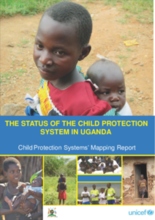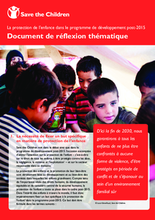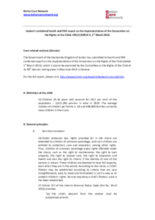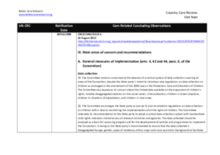Demographic Data
|
Sources: World Bank, UNDP, UNAIDS, DHS 2013 |
Displaying 12601 - 12610 of 14390
This handbook, Moving Forward: Implementation of the ‘Guidelines for the Alternative Care of Children,’ is aimed at legislators, policy-makers and decision-makers, as well as professionals and care providers, to support the implementation of the Guidelines for the Alternative Care of Children, endorsed by the United Nations General Assembly in 2009. It explains the key thrusts of the Guidelines, outlines the kind of policy responses required, and describes ‘promising’ examples of efforts already made to apply them in diverse communities, countries, regions and cultures.
The handbook of the United Nations approved Guidelines for the Alternative Care of Children is to be launched on March 7th, 2013 3:00-4:30pm at Room XXII, Human Rights Council, Palais des Nations, Geneva. The handbook provides practical guidance on moving forward on the road to alternative care provision for children. It highlights implications for policy-making where national governments should provide leadership as well as provides links to what is already being effectively done on the ground.
This paper is a culmination of various studies carried out by the authors and other researchers and seeks to specifically interrogate factors in the family system in Kenya, which contributes to children leaving homes to live on the streets.
This mapping process was commissioned by the Ministry of Gender, Labour and Social Development in order to facilitate the transitioning of Uganda’s approach to child protection from a disjointed, issue-based and project-oriented approach to a more system-oriented approach in order to respond effectively to the multi-dimensional and complex child protection needs of all children in the country.
This is an impact evaluation of New Generation, a three-year project comprised of two components: 1) A VSLA intervention involving the establishment of Village Savings and Loan Associations (VSLAs) and the provision of entrepreneurs
Le programme de développement post-2015 devrait notamment garantir que tout appel à un renforcement des financements des programmes de protection sociale servent à consolider les services de base fournis aux familles - et non aux institutions ou orphelinats - pour mieux soutenir celles-ci dans la prise en charge et la protection de leurs enfants.
Ce travail s’intéresse particulièrement aux violences dont les enfants placés en institutions sont l’objet, entre les maltraitances structurelles propres à l’institutionnalisation, et les maltraitances qu’elles soient physiques, psychiques ou sexuelles. Pour lutter contre ces différentes formes de violence, il conviendra de repenser les institutions actuelles et de chercher des alternatives au placement.
The Government of the Hashemite Kingdom of Jordan has submitted its fourth and fifth combined report on the implementation of the Convention on the Rights of the Child (dated 1st March 2013).
This paper is part of an inter-agency series on the links between child protection and major development goals. The report focuses on the links between child protection and population dynamics as they relate to the post-2015 Millennium Development Goals agenda.
This country care review includes the Concluding Observations for the Committee on the Rights of the Child adopted as part of its examination of Vietnam’s combined third and fourth periodic reports at the 60th Session of the Committee held between 9 May and 15 June 2012. The Committee’s recommendations on the issue of Family Environment and Alternative Care as well as other care relevant issues are highlighted.








